Tuesday, 2 July, Zurich, the lake, expensive real estate, and chocolate!
Written 1 September 2019
Our full day in Zurich began, like our time in Basel, with a bus tour followed by a walking tour. Those were, in turn, followed by a cruise on Lake Zurich. Back to the hotel for lunch, then off again, with the eight other passengers who had signed up for it, to a tour of the Lindt chocolate factory, where the Lindor truffles come from!
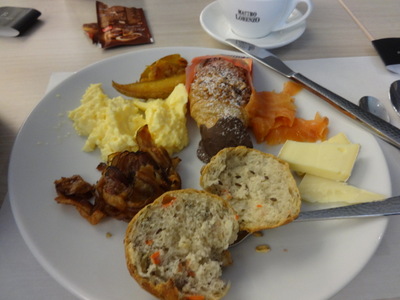
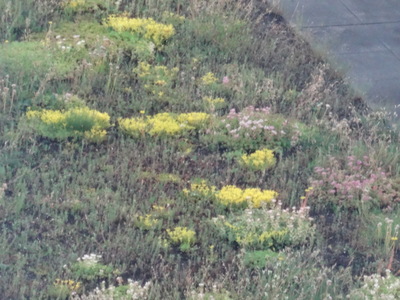 First order of business, though, was breakfast, which was complicated by the temporary closure of the hotel's restaurant for renovation. Regular restaurant operations, including breakfast, had been moved to the bar on the top floor, but he special Viking breakfast was served in a second-floor ballroom, just for us. It featured all the usual suspects, but a particularly nice set of pastries, different from the French and German ones, including this sugar-powdered, almond sprinkled bear-claw sort of thing, one end of which had been dipped in chocolate and which was presented in its own little orange paper bag. Delicious!
First order of business, though, was breakfast, which was complicated by the temporary closure of the hotel's restaurant for renovation. Regular restaurant operations, including breakfast, had been moved to the bar on the top floor, but he special Viking breakfast was served in a second-floor ballroom, just for us. It featured all the usual suspects, but a particularly nice set of pastries, different from the French and German ones, including this sugar-powdered, almond sprinkled bear-claw sort of thing, one end of which had been dipped in chocolate and which was presented in its own little orange paper bag. Delicious!
At the right here is a telephoto of a small patch of the adjacent Technopark roof, showing some of the plant diversity there.
West Zurich Technopark contains 300 startups. The buildings were factories in the 19th century; starting in the middle of the 20th century, the factories were relocated, largely to eastern Europe, and the buildings stood empty. (Okay, that's clearly when they started cleaning up the rivers, but did they do it by just exporting the factories, completely with pollution to eastern Europe?) Eventually, the city renovated and updated the buildings and installed museums, art galleries, clubs, pubs, and start-ups.
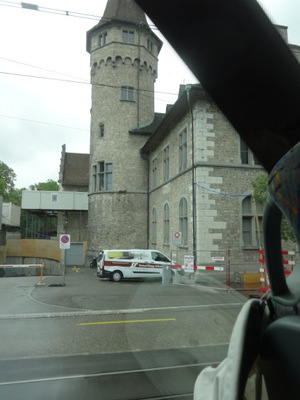
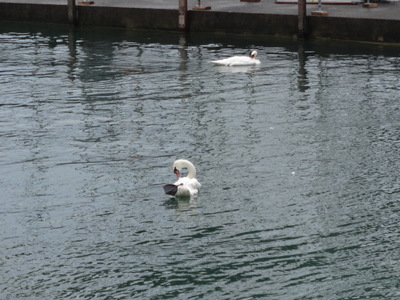 The first landmark the bus took us by was the Swiss National Musuem, housed in a medieval-style building, of which this tower marks one corner.
The first landmark the bus took us by was the Swiss National Musuem, housed in a medieval-style building, of which this tower marks one corner.
Zurich has two rivers, the Limmat (which is the outfall of Lake Zurich) and the Sihl. We drove by their confluence, where a bridge is named for James Joyce, because he like it and visited it often. The rivers had been very low lately, but the previous night's rain had brought them up again. The guide pointed out swimming areas on the far bank (beyond the swans in the left-hand photo). Wickelfisch are available here, but the trend in Zurich seems to be to swim in enclosures protruding into the river, rather than to hop in and go with the current.
We also saw the Swissmill Grainery, 118 m high (exluding the antenna on top). It looks just like an ordinary slab-sided skyscraper and is the second tallest building in Zurich and tallest operating grain elevator in the world. Nearly a third of Switzerland's national grain requirements pass through it (100,000 ton(ne)s of grain/year, most of it grown in Switzerland).
Zurich's train station is even larger and busier than Basel's: 3000 trains and 120,000 people daily. It is also the weekend social center because the shops there are the only ones open on Sunday. Like the one in Basel, it has a huge event hall attached that hosts sports events, conventions, and concerts. A major art work by Nikki de Saint Phalle, "Hanging angel," is displayed there. The 1871 train station is now under a historic preservation order.
A single ticket is good for all forms of transport within Zurich, trains, trams, buses, whatever. I think the same was true in Basel.
The bus also took us past the original flagship Freitag store, which consists of 19 20-year-old shipping containers, stacked irregularly and with doors and staircases to connect them. In 1993 the Freitag brothers, Markus and Daniel, were graphic designers who got around by bicycle, and they needed good water-repellant bags in which to carry their drawings. They were brought up to recycle, so they looked around and realized how many brightly colored old tarpaulins freeway trucks were discarding every year. They started collecting the tarpaulins, together with discarded bicycle inner tubes and old auto seatbelts, and used them to make functional and affordable messenger bags, which everyone calls "freeway bags." Then they diversified into backpacks, handbags, and other gear. They wash the materials with rainwater collected on the roof and heated by a recycling generator. Every bag is unique, because it's pieced together out of the usable parts of whatever tarps are in stock (our guide didn't draw attention to it, but her own backpack said "Freitag" on it). The company is now a real industry, with headquarters in New York City, but the flagship store is still there in the shipping containers.
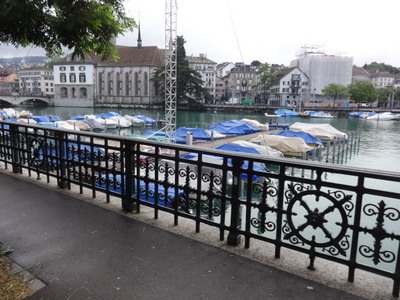
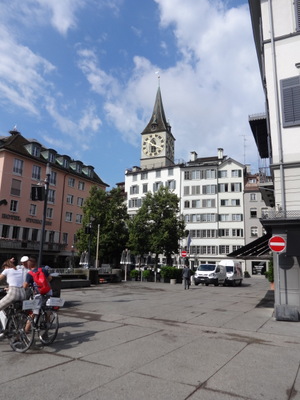 Our walking tour passed by the pleasure-boat basin on the Limmat, right downtown. Apparently, the best way to get a spot there for your boat is to inherit it. You have to pay a monthly fee just to stay on the waiting list for a slip!
Our walking tour passed by the pleasure-boat basin on the Limmat, right downtown. Apparently, the best way to get a spot there for your boat is to inherit it. You have to pay a monthly fee just to stay on the waiting list for a slip!
At the right here is the clock tower of St. Peter's (the city is full of clock towers), viewed from the wine market square. It's one of the four major churches in the old town: the cathedral, the fraumünster, St. Peter's, and the Predigerkirche (which I'm not sure we saw). The clock face in the tower is 8.64 meters in diameter, the largest in Europe.
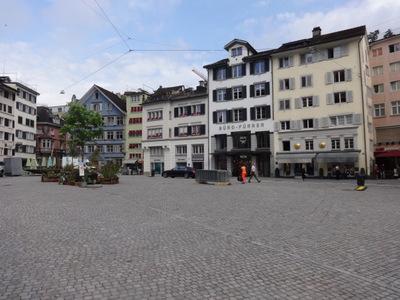
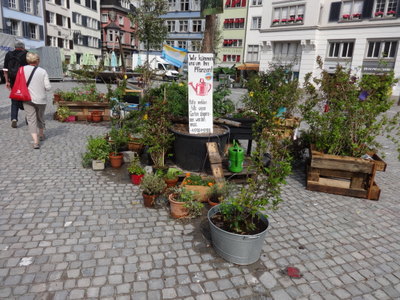 As we approached the large square at the left, it abruptly cleared itself of the motley assortment of delivery vans and trucks that had cluttered it up. It's a pedestrian zone, but trucks are allowed access for deliveries until some particular hour of the morning, and our guide had timed our arrival well. At the far end, near the left-hand edge of the photo is a cluster of greenery, shown in closer view at the right. It's a collection of potted vegetation placed and maintained there in protest of climate change and deforestation. It includes everything from culinary herbs to marigolds, to strawberries, to sunflowers, tomatoes, and small trees.
As we approached the large square at the left, it abruptly cleared itself of the motley assortment of delivery vans and trucks that had cluttered it up. It's a pedestrian zone, but trucks are allowed access for deliveries until some particular hour of the morning, and our guide had timed our arrival well. At the far end, near the left-hand edge of the photo is a cluster of greenery, shown in closer view at the right. It's a collection of potted vegetation placed and maintained there in protest of climate change and deforestation. It includes everything from culinary herbs to marigolds, to strawberries, to sunflowers, tomatoes, and small trees.
Behind the plants, in front of the pink house, you can see a graceful swan-necked fountain.
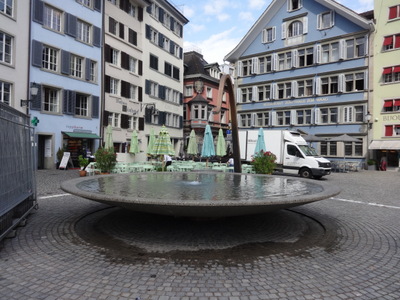
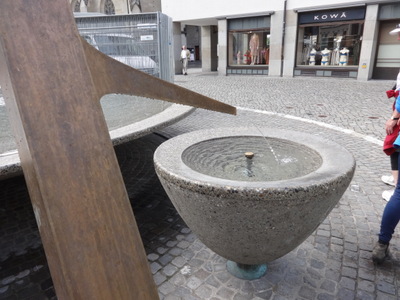 Here's a nearer view of the fountain. Like the ones in Basel, all the public fountains in Zurich (1,224 of them) pour cold potable water, and so far as I know, there's no exception like the Tinguely fountain. Because of the design of this one, though, you'd have to wade in knee deep to stick your bottle under the spout.
Here's a nearer view of the fountain. Like the ones in Basel, all the public fountains in Zurich (1,224 of them) pour cold potable water, and so far as I know, there's no exception like the Tinguely fountain. Because of the design of this one, though, you'd have to wade in knee deep to stick your bottle under the spout.
That's allowed, but it's not always very convenient, so at the side, near the base of the swan neck, a smaller spout sticks out over its own small basin for the convenience of thirsty passers by. This small fountain is the one that pours wine once a year, but here, it's only for a particular exclusive group and not just any passer by.
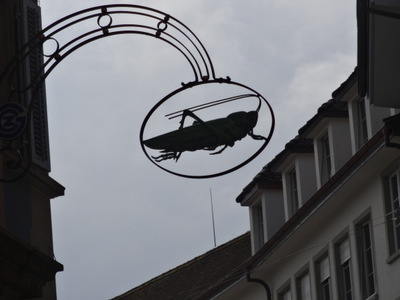
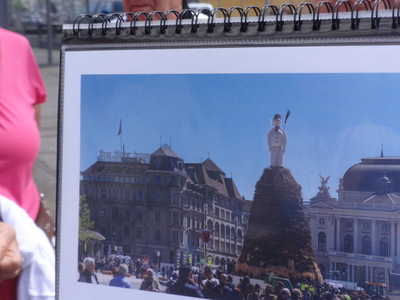 On the way to the center of the old town, from the square with the potted plants, we passed under this grasshopper sign over a restaurant. It was a lovely light green, but the color doesn't show in this silhouette.
On the way to the center of the old town, from the square with the potted plants, we passed under this grasshopper sign over a restaurant. It was a lovely light green, but the color doesn't show in this silhouette.
At the right is a photo that the guide held up to show us a highlight of Zurich's spring festival. In the open plaza in front of the city's opera house (that's the opera house in the background, at the right; the plans were used three times, so there's one like it in Krakow and another someplace else), a huge wooden pyre is built and is topped with a giant snowman. Not only is the pyre helped along with accelerants, but the snowman is packed with explosives—especially the head. On the stroke of 6 p.m. on the first Monday after the spring equinox, the pyre is set alight, and the time elapsed before the snowman's head explodes is sort of the equivalent of our ground hog's shadow—it predicts how fast spring will come and how good it will be. (Originally, according to the internet, the cathedral rang its bells at 6 p.m. on that day every year to mark the beginning of summer work hours, ending at 6 p.m. rather than 5 p.m., and that event came to symbolize the advent of spring.) Once the opyre burns down, you can come grill your food over the embers.
All the guilds still march in procession to the site for the festival, although our guide says they no longer consist of the tradesmen that once made them up. Nowadays, they consist of businessmen and are more like fraternities or social clubs (not clear to me whether membership is hereditary, social, or purchased), but they still dress up in their guilds' respective ceremonial costumes for the procession. The guildes are all men, but just one guild consists of women, and rather than processing, they sit by the wayside handing out flowers to the other guilds. At some point in history, the guilds organized a putsch, took over power in hte city, and held it for hundreds of years.
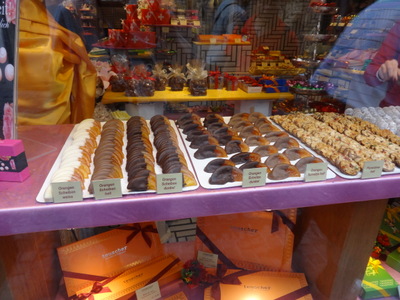
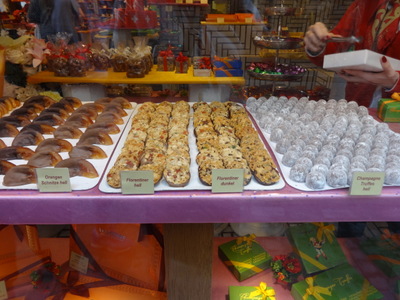 Here's the window of the Teuscher chocolate shop, which we passed on our walk. It took me four shots to show all of it! The assortment starts at the left with glacé orange slices dipped in white, light, and dark chocolate. Then a tray of glacé orange wedges dipped in dark and light chocolate. Then Florentine cookies studded with almond slices and bits of glacé fruit with light chocolate.
Here's the window of the Teuscher chocolate shop, which we passed on our walk. It took me four shots to show all of it! The assortment starts at the left with glacé orange slices dipped in white, light, and dark chocolate. Then a tray of glacé orange wedges dipped in dark and light chocolate. Then Florentine cookies studded with almond slices and bits of glacé fruit with light chocolate.
At the right, the rest of the tray of Florentines, showing the ones with dark chocolate, then a whole tray of light champagne truffles. Something we learned in the course of the afternoon was that all champagne truffles, whatever color they are inside, must be powdered white.
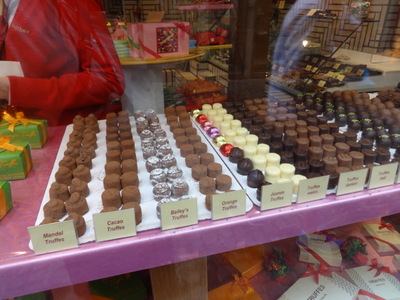
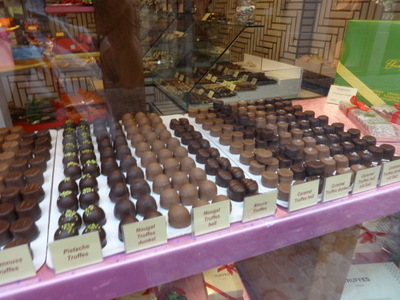 Next came almond truffles, cocoa truffles, Bailey's truffles, orange truffles, jasmine truffles, and white, dark, and light truffles. The foil-wrapped ones at the far end of the line of Jasmine truffles were molded into the shape of Volkswagen beetles.
Next came almond truffles, cocoa truffles, Bailey's truffles, orange truffles, jasmine truffles, and white, dark, and light truffles. The foil-wrapped ones at the far end of the line of Jasmine truffles were molded into the shape of Volkswagen beetles.
Finally, pistachio truffles, dark nougate truffles, light nougat truffles, mocha truffles, light caramel truffles, dark caramel truffles, and light and dark salted caramel truffles.
Some of the larger golden "de luxe" boxes under the tables were priced at 138 Swiss francs (= dollars).
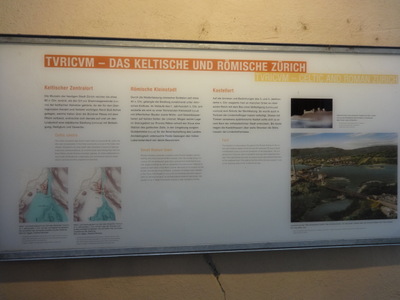
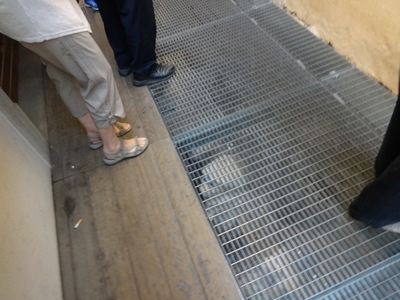 In a covered passage we traversed on our way was this archeological display. At the left is one of the bilingual information panels that lined the walls. (Interestingly, the panels were in German and English, but not in French or Italian.)
In a covered passage we traversed on our way was this archeological display. At the left is one of the bilingual information panels that lined the walls. (Interestingly, the panels were in German and English, but not in French or Italian.)
Underfoot, below these metal grills, were the ruins of the Roman baths of Turicum (the Roman name for Zurich). The earliest ones date from about 7 A.D. and later stages from the 2nd and 3rd centuries A.D. The hot water for the baths was not a natura hot spring but was heated in a boiler by the same fires that fed the hypocaust.
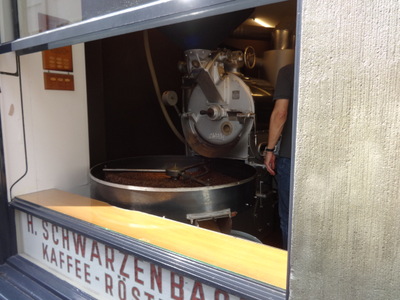
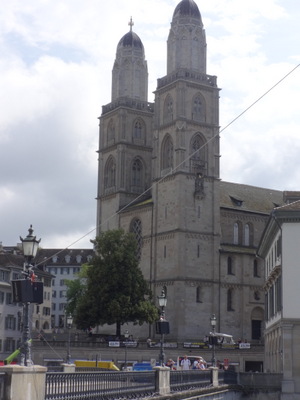 In the heart of the oldest section of town, we came to this coffee shop (selling beans and ground coffee, not the finished drink), the only coffee roaster in the old town. In the open window to the street, the proprietor was tending to the big coffee roaster. They only roast a couple of times a week, and Viking and our guide managed to get us there at the right time. The whole street smelled delicious! In the old town, some of the foundations go back to the 13th century, but the names of the houses date only from the 19th century.
In the heart of the oldest section of town, we came to this coffee shop (selling beans and ground coffee, not the finished drink), the only coffee roaster in the old town. In the open window to the street, the proprietor was tending to the big coffee roaster. They only roast a couple of times a week, and Viking and our guide managed to get us there at the right time. The whole street smelled delicious! In the old town, some of the foundations go back to the 13th century, but the names of the houses date only from the 19th century.
Finally, after admiring a long series of very tempting shop windows, we emerged within sight of the cathedral, the Grossemünster, shown here at the right.
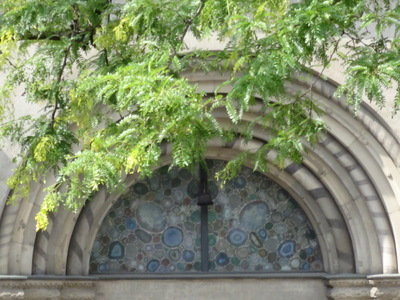
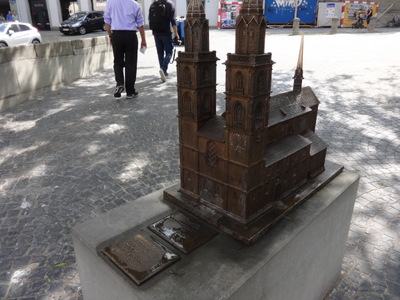 Unfortunately, photography was forbidden inside the cathedral, but here, at the left, is a view of the outside of a particularly nice "stained glass" window, above the door we went in. Rather than glass, it's made of a mosaic of thin slices of agates, large and small. It's amazing enough from this side, but from indoors, with the sun behind it, it was gorgeous. If you want to climb the 287 steps, you can visit the cathedral tower. We didn't (and wouldn't have even if the tour allowed time).
Unfortunately, photography was forbidden inside the cathedral, but here, at the left, is a view of the outside of a particularly nice "stained glass" window, above the door we went in. Rather than glass, it's made of a mosaic of thin slices of agates, large and small. It's amazing enough from this side, but from indoors, with the sun behind it, it was gorgeous. If you want to climb the 287 steps, you can visit the cathedral tower. We didn't (and wouldn't have even if the tour allowed time).
As usual, a bronze model of cathedral with Braille labels was provided for the blind.
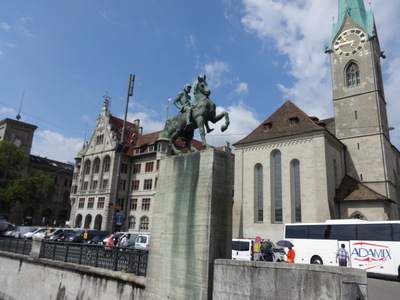
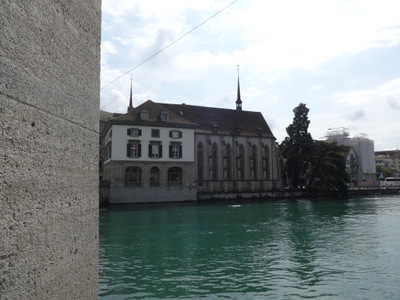 Across the river from the cathedral (and running along one side of the square with the swan-necked fountain) is the Fraumünster, the womens' church. The gold clock dates from 1732. The abbey was founded in 853, on the remains of a former abbey for aaristrocratic women, by Charlemagne's grandson Louis for his daughter Hildegard. Because it was under his direct authority, the Grossemünster had no authority over it, even though it was the senior institution, founded by Charlemagne himself. A later king granted the convent, which already owned a lot of land, the right to hold markets, collect tolls, and mint coins, so the abbesses were very powerful. The bishops in the Grossemünster weren't happy about it, but they couldn't do anything about it. The nunneries were closed after the reformation, and in the 1520's the church was handed over to the city. For 5 francs, you can go in with an audioguide to see the Chagall windows, but we didn't.
Across the river from the cathedral (and running along one side of the square with the swan-necked fountain) is the Fraumünster, the womens' church. The gold clock dates from 1732. The abbey was founded in 853, on the remains of a former abbey for aaristrocratic women, by Charlemagne's grandson Louis for his daughter Hildegard. Because it was under his direct authority, the Grossemünster had no authority over it, even though it was the senior institution, founded by Charlemagne himself. A later king granted the convent, which already owned a lot of land, the right to hold markets, collect tolls, and mint coins, so the abbesses were very powerful. The bishops in the Grossemünster weren't happy about it, but they couldn't do anything about it. The nunneries were closed after the reformation, and in the 1520's the church was handed over to the city. For 5 francs, you can go in with an audioguide to see the Chagall windows, but we didn't.
Today, the city and the canton are officially protestant, but the city is majority Catholic.
At the right is the "water church," built on a little island in the Limmat, between the two münsters. The guide seemed to say that it was longer an island but now connected to the bank.
The statue in the foreground of the left-hand photo is Hans Waldmann, who led the Swiss in their decisive defeat of Charles the Bold (or, as I always call him, Charles the Pushy) of Burgundy in 1474. Don't know whether he carried only the ax shown here during that battle. A few years later he became mayor of Zurich, but his land-reform policies angered Swiss farmers, who got him executed six years later. The guide didn't tell us about him, but I looked him up out of curiosity. Amazing what Google can do with a search string like "equestrian statue with ax in Zurich." Traditionally that single raised hoof on the horse would mean he died of wounds received in battle; maybe political battles count.
Written 3 September 2019
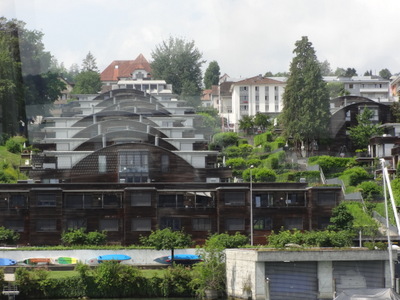
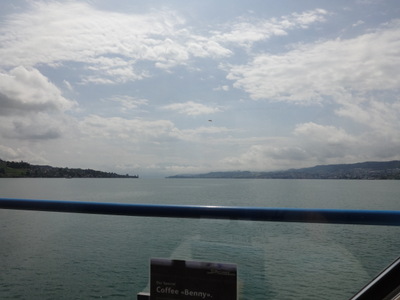 Our walking tour ended at the waterfront. Zurich sits wrapped around the northern tip of the long, narrow Lake Zurich. For those who whose not to take the lake cruise, the guide pointed out the tram that would take them back to the hotel after they continued their stroll on land. The rest of us piled aboard a boat for the 1-hour counterclockwise circuit along one bank, across the lake, and back along the other bank. Around the boat slip, I saw swans, cormorants, and one moorhen (not to mention some folks on stand-up paddle boards). Our circuit was the shortest available—3-hour, half-day, and full day cruises were also offered. Our guide narrated for us in English over the PA system, but some locals were clearly aboard using the boat for transportation rather than tourism. Waiters circulated, taking drink orders, but we abstained.
Our walking tour ended at the waterfront. Zurich sits wrapped around the northern tip of the long, narrow Lake Zurich. For those who whose not to take the lake cruise, the guide pointed out the tram that would take them back to the hotel after they continued their stroll on land. The rest of us piled aboard a boat for the 1-hour counterclockwise circuit along one bank, across the lake, and back along the other bank. Around the boat slip, I saw swans, cormorants, and one moorhen (not to mention some folks on stand-up paddle boards). Our circuit was the shortest available—3-hour, half-day, and full day cruises were also offered. Our guide narrated for us in English over the PA system, but some locals were clearly aboard using the boat for transportation rather than tourism. Waiters circulated, taking drink orders, but we abstained.
We stopped briefly at three or four villages on each bank, some near enough to be considered part of the city and others outside its boundaries. One of the first things we passed was the building at the left—it almost looks like a multiple exposure, but it was one of two lines of condos stepping up the hill from the lake shore. The guide explained that the closer to the lake, the higher the land prices. You'd pay $4–5 million to get a house with a view of the lake. (In the city center, a two-room flat would be $3–4 million.) Land just over the top of the hills on either side, and thus without a view of the lake, was much cheaper (but by no means actually cheap). IBM research labs are also located on the lake, near this area; at least two Nobel prizes have come out of this little village. As along the coastline of California, a constant discussion continues over complaints that the expensive houses come right down to the edge of the lake, blocking public access.
Zurich is divided into 12 numbered districts; the city center is district 1. Our hotel is in district 5, and Google has its second largest engineering office, 50,000 square meters, in district 4 (one district closer to the center than our hotel).
On this side of the lake, we also passed a low red-brick building right down the water's edge. It was a silkweaving factory (back when textiles and dyeing were big in town), but now it's a cultural center covered with colorful graffiti. Elsewhere in town, we were shown the former stables of the Swiss army, now a cultural center that offers dance classes>.
Also on this side was a handsome building on the lake edge with large arched doors—a rowing club.
As we turned left to cross the lake, I got this shot (at the right) down its length. At this location, we were perhaps halfway between Zurich and the point at which the lake vanishes in the distance, and the vanishing point only marks the place where the lake curves out of sight. From Zurich to the vanishing point represents only about a third of the lake's total length.
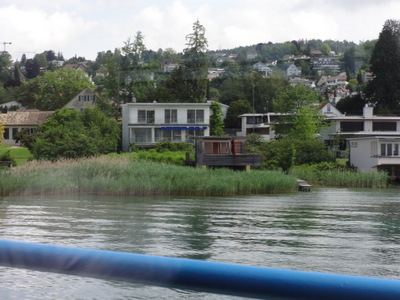
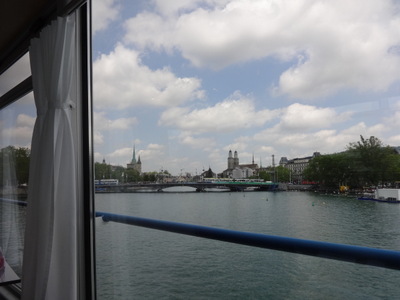 Coming back along the other bank, we passed this point, where Tina Turner lives. The guide said "where the three flags are by the little yellow house and the little wooden house." You can clearly see the little wooden house (not a dwelling, but someone's lakeside cabana), and the little yellow house may be the one at the left edge of the photo, but I never spotted any three flags.
Coming back along the other bank, we passed this point, where Tina Turner lives. The guide said "where the three flags are by the little yellow house and the little wooden house." You can clearly see the little wooden house (not a dwelling, but someone's lakeside cabana), and the little yellow house may be the one at the left edge of the photo, but I never spotted any three flags.
Anyway, Tina is now a Swiss citizen; she gave up her U.S. citizenship to get it. She apparently likes the freedom being here where no one stops her and asks for autographs; the guide didn't make clear whether that's because people here don't know who she is or whether they're just too cool to hassle celebrities. Anyway, after living here, you can apply for Swiss citizenship. You have to be granted citizenship in the canton before you can get it for the country. The process also includes an unannounced police visit to ask you questions about Switzerland, which you have to answer correctly to be accepted. The guide said she entertained local politicians at a big party when she got married, in preparation for getting canton citizenship.
They even grow some grapes on this hillside above the lake (maybe it gets more sun?), for rosé and sparkling wine, all organic. And halfway up the hillside is a huge building that used to be a sanitorium but is now a luxury hotel, catering to the likes of Winston Churchill and Michael Jackson. Once a year they have a "sale," offering rates accessible to the masses, but you have to be quick because they get booked up really fast.
At the right is a photo I took during our approach to the waterfront at the end of the cruise. You can see the Grossemünster (with the rounded towers) facing the Fraumünster (with the pointed spire) across the river. Two blue and white trams are crossing the bridge from different directions.
The lakefront of the city was being prepared for the upcoming Zurichfest, which would begin on on Friday and end on Sunday. It would include fireworks, gastromy, and sporting and cultural events, including Swiss wrestling (Schingen, the national sport), which was originated by brawny Swiss farmers; it's something like sumo wrestling. The winner of the triennial championship is the king of Sweden for the next three years; the prize is a bull.
An inflatable water slide was being set up (in front of a Tinguely sculpture called "54, machine without a function"). The slide is on the site of alarge open-air summer cinema, which will start in a few weeks. At some point, the guide said there would be a parade of trucks carrying dancers and lost of techno and electric music, but I'm not sure whether that was part of this festival or a different one. Near the water slide was a "face club" tower with what look like harnesses attached; I think they drop you and then set you down gently, sort of like bungee jumping? A barge has been anchored out in the lake for shooting fireworks during the festival, and this year a flock of drones will make aerial flower pictures as part of the display.
The guide also mentioned several marathons. One is run on St. Sylvester's day (New Year's Eve), and the Zurich marathon is run at the summer festival (presumably the festival now coming up?). And the Zurich Iron Man lets you qualify for the Hawaiian Iron Man. And she mentioned the Swiss national ice hockey team. And that the city holds weekly rollerblade rallies.
Then there's "hornussen," a really strange farm sport in which a player swings what looks like a golf club ending in a 5-foot whip with a block on the end. He swings such that the block engages and slides up a metal ramp to strike a "hornuss" (hornet), a hard rubber puck that flies up to 300 mph, buzzing like a hornet. The opposing team (10 or 15 of them) stand along its course holding tall wooden paddles, with which they attempt to knock it down as it passes. Weird.
More stuff the guide told us at one point or another:
The city's casino is ugly on the outside (we drove past it, and she's right—it reminds me of the Tallahassee Greyhound bus station), but, she assured us, is lovely inside.
Zurich is the largest city in Switzerland, with 420,000 inhabitants in the city proper, 1.3 million in the agglomeration, and 1.5 million in the canton. In the 13th century, the city was walled. In the 18th century, it had a large star-saped fortification. In the middle of the 19th century, it was the second after England to develop an industrial center. In 1893, Zurich became the largest city and had 10 districts; a second incorporation in 20th century got it up to the current 12. The city can offer a lot in educational and cultural life; supposedly it has the highest quality of life worldwide. No matter where you live, you are within 15 minutes' walk of a green park or forest; 1/4 of city's surface is green. The city has 80,000 trees ("mostly lindens" the guide said, although we were standing where not a linden was in signt, and she couldn't identify three of the species that surrounded us), which are replaced as needed. I didn't see numbers on the trees, but again, maybe there's a database. The French make linden-flower tea, but in Zurich, somebody makes linden-flower-flavored gin.
The city's flag is half blue and half white.
From the city center, the guide pointed to a wooded hilltop in the distance and said that, in the winter, when the city is persistently foggy and dreary, you could take the tram up there to get out of the fog and into the sun. When one of our group asked if she could just drive up there herself instead, she replied, "Yes, but why would I, when the tram is so much more convenient?" To go skiing, you take a train 45 min toward the Alps.
In the square at the foot of Bahnhof Strasse (Railway station street), on Tuesdays and Saturdays there's a vegetable and fish market. On Saturdays, there's also a flea market. The Bahnhoff Strasse is the world's third most expensive shopping street; things are cheaper toward the train station, more expensive toward the lake.
The lake and river are very clean and are the source of the city's drinking water, despite heavy recreational use. (In fact the whole city is very clean; the streets are scrubbed daily with huge, stiff, truck-borne rotary brushes that reach right down between the cobble stones to get the grime out. Switzerland is also a world leader in recycling.) The goal is to get people down from 4000+ to 2000 watts (kilowatts?) a year/head, to satisfy the standards for sustainability.
In the city center, separate enclosed swimming areas for men and women protrude out into the river, furnished with bars and snack shops. You're allowed to swim anywhere, but the lifeguards are in the enclosures. In the evening, the enclosures go coed. Each of the villages on the lake also has a public swimming area.
The Paradaplatz, near the town center, is the big financial center. Switzerland became a large financial center during WWI and WWII, when lots of people put their money in Swiss banks because the country was neutral. When we crossed the bridge toward the old town and shopping district, the guide said we were leaving the side of town where the money is made and going to the side where it is spent.
In Zurich, income taxes are 15–20% (I think it varies by canton). About 6% people of people get minimum income from social wellfare and on are on the breadline; they can buy only necessities. Unemployment is very low, ca. 3% in Zurich canton and 3.5% for Switzerland overall. Unemployment pay is 707ndash;80% of your last salary, for two years; you have to show up monthly at the unemployment office and prove you're looking for a job. The unemployment people will also search for a job for you; if you turn it down, you only get one or two more months of support. If you come to Switzerland as an immigrant, you have to prove that you can support yourself, i.e., bring lots of money with you or have a job here.
In the villages on the lake that are outside Zurich city, taxes are about 18% lower, but the apartments are more expensive in the city.
The big expenses for the Swiss are health insurance and housing. Health insurance is compulsory. For low-income people, health insurance is partially subsidized; if you have a high income, you pay all of it.
Housing coops get favorable land prices from the government. You buy into a coop, and the coop invests the money (if you leave, you get time money back). Proceeds from the investment are applied to lower your rent. This system has helped a lot of low income people improve their financial situation. Coops have waiting lists for people who want to get in because your rent can be half that on the open market. A number of coops are located on the shores of the lake, having gotten in on the ground floor, as it were.
Luther never came to Zurich, but Huldrych Zwingli started the Swiss-German reformation in 1520 (Luther's theses, 1517). Luther and Zwingli knew and disliked each other. Zwingli didn't destroy or pillage the churches, but he organized calm removal of all their ornamentation. He was killed by the Catholics in 1531.
Kid's would still be in school for another two weeks. They start at 7 a.m., have to be there for 5 hours, then get 2-hour lunch, then 2, 3, or 4 hours in the afternoon. I didn't find out whether they got lunch at school or went home for it. After kindergarten come 6 years of primary school. Then a test to get into the "gymnasium," which is the university prep track. Or they can go on to 2–3 years of secondary school, then test into gymnasium or university. Or they can do 3 years of secondary and then start an apprenticeship and go to school 2 days a week. You can apparently reintegrate into the university track later on, but not everyone is ready at 16.
The Swiss eat 10.5 kg of chocolate per capita per person, but the Germans eat more. The Swiss also eat a lot of cheese, especially stinky ones, and they make fondue and raclette.
Switzerland has two major grocery chains, and Swiss families tend to be either Migros or Coop grocery shoppers. Our guide's family were Coop shoppers.
The fourth languageSwitzerland's fourth language is Rhaeto-Romansh, spoken mainly in the southeasterb canton of Grisons.
Major industries include graphics, electrical optical products, life sciences, biomedical, cinema, theater, and architecture.
Historic buildings are preserved, but all buildings have to be safe, even the ones that date to the middle ages, so discrete modifications are made as needed.
When the modern country was founded, it was with freedom of religion. Zurich as 16 mosques, but no minarets because the population voted to have no minarets (they vote on everything here). The city has one of the larges Jewish communities in Europe, and one district houses a large populaion of Jews, with their own customes, schools, and special construction practices. Although the city and canton are official protestant (at one point, if you lived in Zurich canton but outside the city, you had to declare yourself protestant or you couldn't live there)), the city is 27% Catholic, 23% protestant, 2% Jewis, and some small percentage muslim. The city is majority Catholic because of all the immigrants who came to build its infrastructure. The majority were Italian, but many were Germans, Portuguese, Spanish, Turkish, and since the 1990's, eastern European. The government built chapels (not churches) to accommodate them. In all 174 nationalities are represented in the city, and 1 out of 3 citizens is a foreigner.
Mennonites originally came from Zurich, as did the first anabaptists. They didn't believe in infant baptism but in baptism later in life, when the individual was old enough to choose to undergo it. Others complained that early baptism was important because infant mortality was so high. Early anabaptists were killed by being thrown into the river in January. Many moved away, including to the U.S.
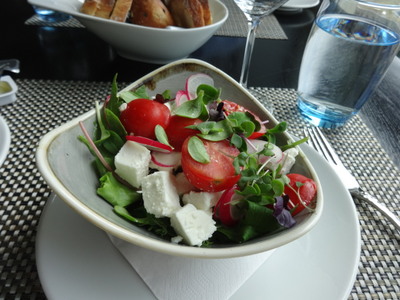
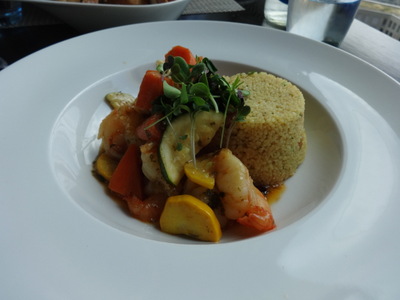 When our tour ended, buses picked us up for the ride back to the hotel. We were leaving again in short order for our afternoon visit to the chocolate factory, so we just went to the hotel's makeshift restaurant and ordered the daily special. It started with the salad at the left, which included big chunks feta cheese.
When our tour ended, buses picked us up for the ride back to the hotel. We were leaving again in short order for our afternoon visit to the chocolate factory, so we just went to the hotel's makeshift restaurant and ordered the daily special. It started with the salad at the left, which included big chunks feta cheese.
The main course was a Morrocan shrimp couscous. A little odd but very good. With it, we drank the local brand of bottled water, Henniez, which turned out to be good, like French bottled water rather than resembling that awful German stuff. We didn't bother with dessert; we were short of time and besides we were on our way to the fount and wellspring of Swiss chocolate.
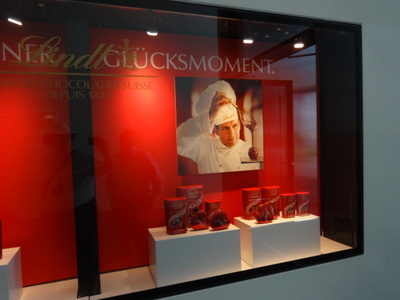
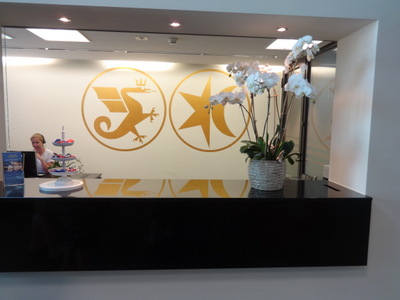 Surprisingly, only 10 people signed up for the chocolate visit, so they took us around the lake to the factory in a special smaller bus. At the left here is the beautiful lobby we were ushered into. In the glass cases were giant versions of the opulent ads the company runs in magazines like Saveur and Bon Appetit.
Surprisingly, only 10 people signed up for the chocolate visit, so they took us around the lake to the factory in a special smaller bus. At the left here is the beautiful lobby we were ushered into. In the glass cases were giant versions of the opulent ads the company runs in magazines like Saveur and Bon Appetit.
Next, we paused before the reception desk, decorated with real orchids and, of course, real chocolate, of which we were invited to partake.
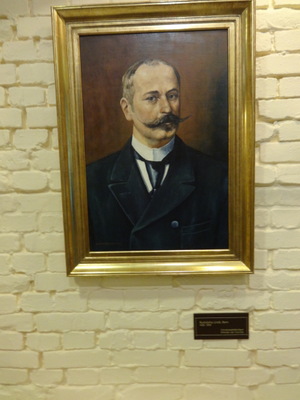
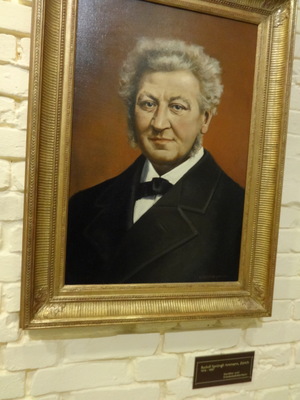 Then, upstairs, under the watchful eyes of these portraits of Mr. Lindt (left) and Mr. Sprungli (right) we were given a little history.
Then, upstairs, under the watchful eyes of these portraits of Mr. Lindt (left) and Mr. Sprungli (right) we were given a little history.
Consumption of chocolate started about A.D. In 1528, Hernan Cortez brought it to Europe. In the 17th and 18th century, about 15 chocolate beans would buy a chicken. Up until then, chocolate had been only for drinking, but in the 17th and 18th centuries, solid chocolate was introduced. The process of making it was industrialized, and eventually milk chocolate was introduced.
In 1845, Rudolf Sprungli started production of solid chocolate in the region of Zurich, but the solid chocolate of that day was hard and grainy. In 1879, Rudolphe Lindt invents the conching process, which produces the first tender, melting chocolate. Actually it happened by accident. Lindt left the chocolate grinding machine, called a conche from its shell-like shape, on overnight, and in the morning found it full of a substance of a whole new flavor and texture.
In 1899, Sprungli took over the present factory, brought in Lindt as a partner, together with his secret conching process, and formed Sprungli and Lindt, still the official name of the company.
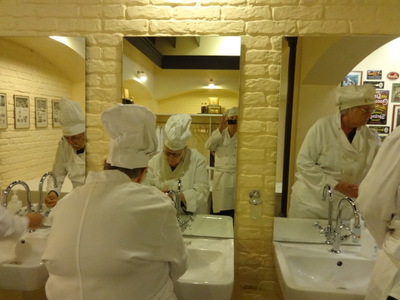
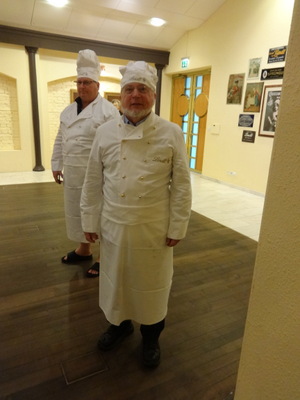 In a special spacious dressing room, lined with hand-washing sinks, we were presented with our official chocolate-making attire and suited up. In the left-hand photo, you can see me in the mirror, camera in front of my eyes. As you can see, my apron is hanging crooked.
In a special spacious dressing room, lined with hand-washing sinks, we were presented with our official chocolate-making attire and suited up. In the left-hand photo, you can see me in the mirror, camera in front of my eyes. As you can see, my apron is hanging crooked.
David did a better job with his, which hangs straight and looks very professional. Note how we were instructed to fold the tops of our aprons over, then to tie them with the strings well below the top edge of the fold, which could then be folded down over the strings, leaving a smooth front. David's is perfect.
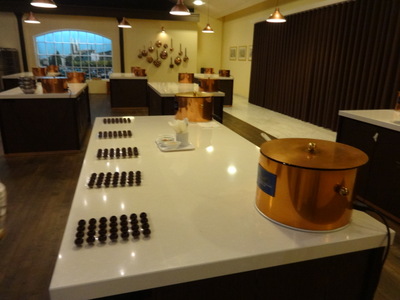
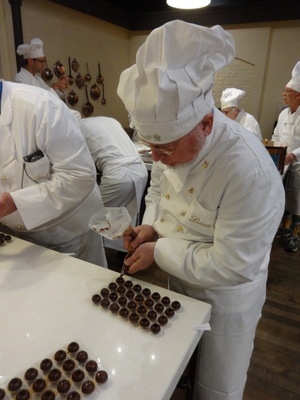 Next, we passed through swinging doors into the "Chocolateria," a sort of kitchen/lab with gleaming marble benchtops and water-jacketed copper warming vats full of milk and dark chocolate. You can only see about a quarter of it here. Mostly out of the shot to the right is the table, centered at the front of the room, with plastic display models of cocoa pods, seeds, and nibs.
Next, we passed through swinging doors into the "Chocolateria," a sort of kitchen/lab with gleaming marble benchtops and water-jacketed copper warming vats full of milk and dark chocolate. You can only see about a quarter of it here. Mostly out of the shot to the right is the table, centered at the front of the room, with plastic display models of cocoa pods, seeds, and nibs.
Before we started the hands-on portion, the chef in charge showed us a few slides of the chocolate-making process, starting with growing and harvesting the pods. When the ripe pods are opened, the pulp-covered beans are fermented between banana leaves to get the pulp off. The beans are dried in the sun until they're down to about 5% water before being roasted. Some companies roast the whole beans; Lindt grinds them to nibs first, to get more even roasting. From the nibs, the very bitter cocoa liqueur is produced, and the cocoa butter (about 50%) is separated. The chef was indignant at the idea that some people say that white chocolate isn't really chocolate. It's mostly cocoa butter, and that's as much a product of the cocoa bean as the brown part. (One of the slides showed Jack Black, who had done this tour, clowning with his finished truffles.)
A modern conching machine can process about 10 ton(ne)s in 12 hours, and the factory has 20 of them. They produce 12 million Lindor truffles a day.
On the benches, waiting for us, were hollow dark-chocolate turffle shells. Each of us got a whole tray of 28. In the copper kettles was liquid cocolate that had already gone through the very complicated "tempering" process, where the mixture is heated, then cooled, then heated again, cooled again, each time to a different precise temperature. The result is chocolate that has had just the right components melted, crystalized, or whatever to cool and dry with a glossy surface, just right for making dipped chocolate. After the slide show, the assistant chef scooped liquid champagne-flavored ganache (ganache is a mixture of chocolate and cream; yes, they used real champagne; no, they didn't tell us the formula) into a pastry bag for each of us so that we could fill our truffle shells. He demonstrated on a few, to show us just how full we should make them. At the right here, David is carefully piping the mixture into his truffles.
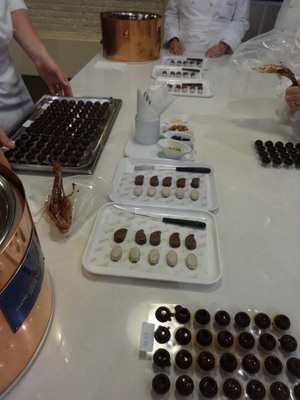
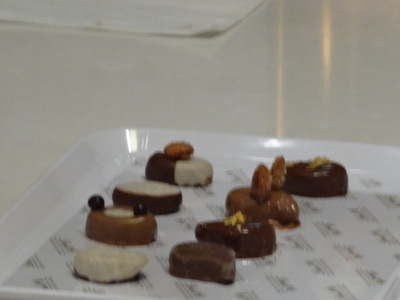 When we had all successfully filled our truffles (and spilled only a few splodges of liquid chocolate onto the trays and benches) the assistant took them to a nearby fridge to be gently cooled and solidified.
When we had all successfully filled our truffles (and spilled only a few splodges of liquid chocolate onto the trays and benches) the assistant took them to a nearby fridge to be gently cooled and solidified.
Next, we were each given a little tray with 10 ready-made centers for dipped chocolates, five oval ones with a light white primer coat and five teardrop shaped ones with a dark primer coat. The chef demonstrated how to use a tiny, long-handled, three-tine fork made of wire to dip the centers on his tray, some in milk and some in dark chocolate, some all the way in and some only part way to leave part uncovered. Then he demonstrated how to decorate the pieces, while the coating was still soft, using elements that were provided in little dishes in the middle of each table.
Meanwhile the assistant was filling tiny little miniature paper pastry tubes with light, dark, and white chocolate. As he rolled and filled each one, he folded it shut and laid it in the gutter that ran around one of the kettles to stay warm. The photo at the right shows the initial stage of the chef's decoration.
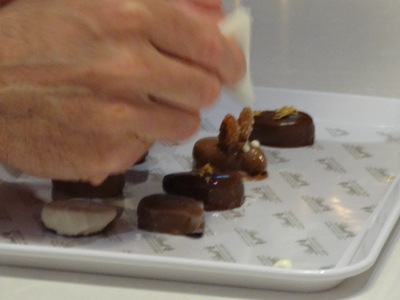
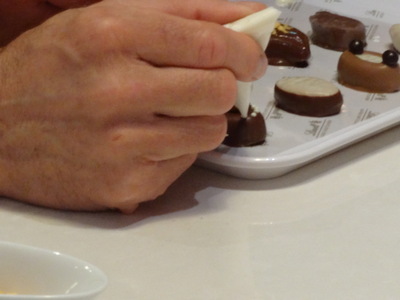
When he had finished applying his initial decoration (toasted coconut shreds, fake gold leaf made from candy, sugared whole almonds, tiny spherical malted milk balls), he used a couple of the tiny pastry bags to add detail. At the left here, he's applying dots of white chocolate to make eyes on his tiny chocolate mouse. The "ears" are sugared almonds. With the decorations on the tables were jars holding more tiny parchment-paper triangles, in case we wanted to make more tiny cones, as well as pens for marking our trays. Somebody accidentally dropped one of her little pastry bags into her kettle, but the assistant immediately made another for her.
At the right, the chef is applying a row of tiny, uniform dots around the periphery of an oval piece.
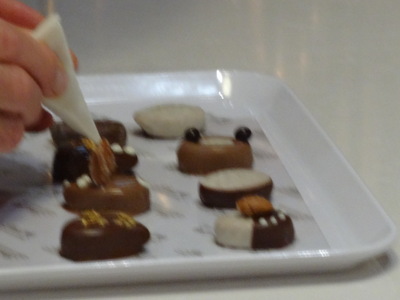
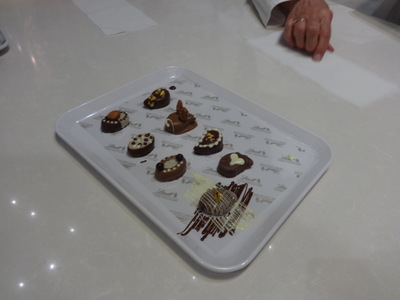 At the left here, he's preparing to make even tinier dark chocolate dots to serve as pupils in the little mouse's eyes.
At the left here, he's preparing to make even tinier dark chocolate dots to serve as pupils in the little mouse's eyes.
At at the rght, you can see that he used white chocolate to pipe a little curly white tail onto the mouse's backside. He also demonstrated how to make a little white chocolate heart and how to apply two contrasting colors of chocolate streaks across an oval.
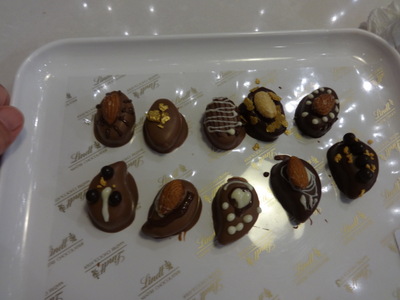
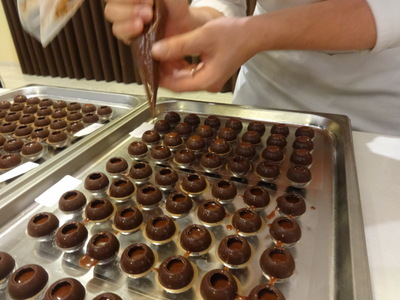 Then it was our turn. By this time, the assistant had filled enough tiny pastry bags for everyone, and they were waiting for us on the edges of our kettles. Everybody got a dipping fork. I choose to dip all of my centers entirely into the milk chocolate in the nearest kettle, then to apply some of every kind of decoration and to pipe on detail. Mine aren't as neat as the chef's, but I thought they came out very well. I chose not to make a mouse, because I knew we were going to have to try to get these home on the plane, and the standing-up ears seemed awfully fragile. David's also came out great.
Then it was our turn. By this time, the assistant had filled enough tiny pastry bags for everyone, and they were waiting for us on the edges of our kettles. Everybody got a dipping fork. I choose to dip all of my centers entirely into the milk chocolate in the nearest kettle, then to apply some of every kind of decoration and to pipe on detail. Mine aren't as neat as the chef's, but I thought they came out very well. I chose not to make a mouse, because I knew we were going to have to try to get these home on the plane, and the standing-up ears seemed awfully fragile. David's also came out great.
While we dipped, sprinkled, and piped, the assistant was busy again, capping our truffles (right-hand photo) and putting them back in the fridge to harden the caps.
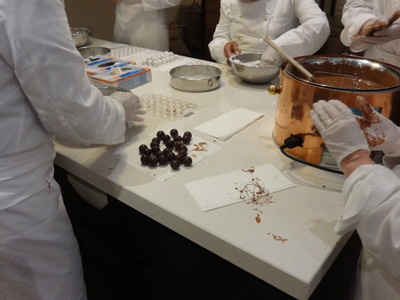
 We weren't finished yet! By the time we finished decorating our dipped chocolate, the caps on our truffles had hardened, and it was time for the last touch—champagne truffles have to be powdered white, right?
We weren't finished yet! By the time we finished decorating our dipped chocolate, the caps on our truffles had hardened, and it was time for the last touch—champagne truffles have to be powdered white, right?
We teamed up in pairs; David and I worked together, of course. I put on the thin rubber gloves supplied for the purpose and, following the chef's instructions, I dipped the ends of my right fingers into the kettle and used them to smear chocolate on my right palm. I then picked up two truffles, rolled them in my palm to get them sticky with chocolate, and dropped them into the large bowl of powdered sugar that David was tending. Two at a time, I rolled and dropped all the truffles.
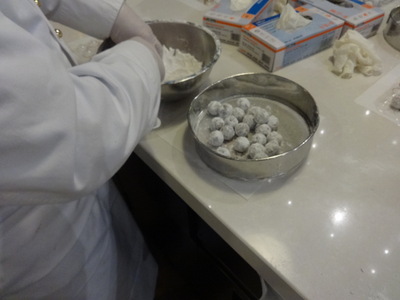
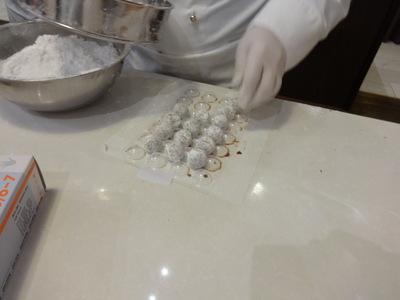 David meanwhile tossed them in the sugar to make sure they were entirely coated, then transferred them to a drum sieve (left; just like the ones he used to use in the lab!), rolled them around gently to remove excess sugar, and transferred them back to their trays to harden and dry. which only took a few moments.
David meanwhile tossed them in the sugar to make sure they were entirely coated, then transferred them to a drum sieve (left; just like the ones he used to use in the lab!), rolled them around gently to remove excess sugar, and transferred them back to their trays to harden and dry. which only took a few moments.
Once we had stripped off our gloves and listened to a few more instructions, we packed our finished chocolates into gold-embossed Lindt boxes with blue ribbons, using "pillows"—those puffy glazed corrugated paper pads—to separate two layers of decorated chocolates and piling all the truffles to taller boxes designed for them.
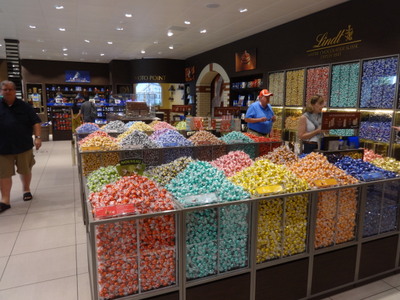
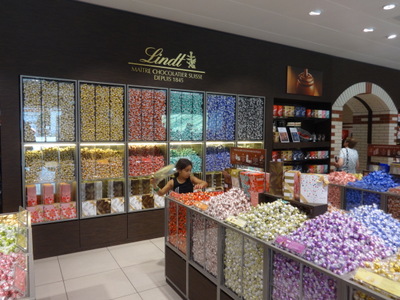 Carrying our boxes in the little designer Lindt shopping bags we were given for the purpose, we piled back into our bus for the trip around the block to the flagship Lindt chocolate shop. At the door, we were greeted by a hostess pressing upon us samples of the latest Lindor truffle flavor—pistachio. At the left is part of the section of the store devoted to filling your shopping bag with your own selection of Lindor truffles. And it is worth noting there that this was photo #9999 on my camera, which, with the next shot, rolled over and started again at #1.
Carrying our boxes in the little designer Lindt shopping bags we were given for the purpose, we piled back into our bus for the trip around the block to the flagship Lindt chocolate shop. At the door, we were greeted by a hostess pressing upon us samples of the latest Lindor truffle flavor—pistachio. At the left is part of the section of the store devoted to filling your shopping bag with your own selection of Lindor truffles. And it is worth noting there that this was photo #9999 on my camera, which, with the next shot, rolled over and started again at #1.
At the right is photo #1, more truffles. And this is only part of one room. Shelves in a couple of rooms offered every chocolate product Lindt and Sprungli make, and some of them in impressively large sizes! Chocolate bars in intense fig, intense orange, lemon, stracciatella (vanilla chocolate flake), fleur de sel, caramel à fleur de sel, chili, cocoa, intense pear. Little square boxes of mini pralinés that sometimes show up at our parties in Tallahassee. 2.5 kg bags of Lindt mini bars. Large spherical packages of truffles wrapped to look like giant truffles. Brownie, chocolate mousse, torte, and tortino mixes. Lindor truffles in mint, hazelnut, coconut, caramel, pistachio, strawberries and cream, citrus flavors, in addition to all the usual ones we get. Chocolate ladybugs ("glückskäfers"). Amazing. And I forgot to mention that while we were making our chocolates, the front desk in the room displayed a variety of chocolate bars that we were encouraged to open and taste.
David declared this afternoon's activity the best of the entire trip!
Written 4 September 2019
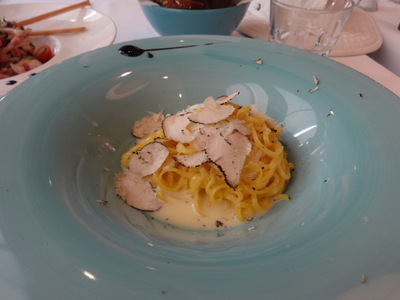
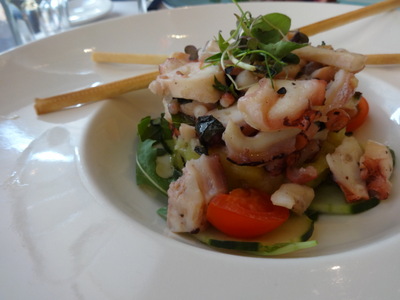 Back at the hotel, we decided to stick with a winner and just strolled back over to Toscano for dinner. The lady at the table beside us the evening before had raved about her tagliolini with black truffles, so I ordered that and the octopus-and-potato starter, to be served together, since David was ordering only a single course.
Back at the hotel, we decided to stick with a winner and just strolled back over to Toscano for dinner. The lady at the table beside us the evening before had raved about her tagliolini with black truffles, so I ordered that and the octopus-and-potato starter, to be served together, since David was ordering only a single course.
She was right. I got a mound of that fantastic house-made pasta in a light but deeply truffle-flavored cream sauce, showered with shaved truffles, and buried within the mound, half of a warm burrata cheese. Wow.
The octopus was served cold, sliced and shaped into a timbale atop of disk of cold potato salad. Long skinny "grisini" breadsticks on the side.
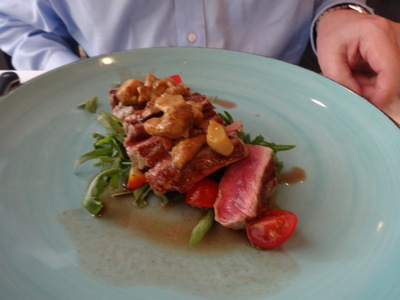
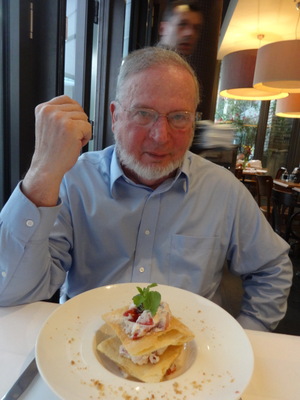 David chose the ribeye steak, which was grilled, then sliced thickly and stacked atop a pile of arugula and tomatoes and topped with a sauce of porcini mushrooms.
David chose the ribeye steak, which was grilled, then sliced thickly and stacked atop a pile of arugula and tomatoes and topped with a sauce of porcini mushrooms.
For dessert, he ordered the strawberry mille-feuilles, sheets of crisp puff pastry stacked with a mixture of sliced strawberries and whipped cream, which he declared eminently satisfactory.
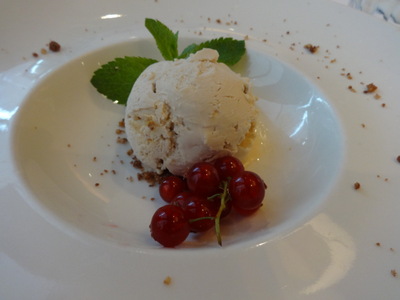
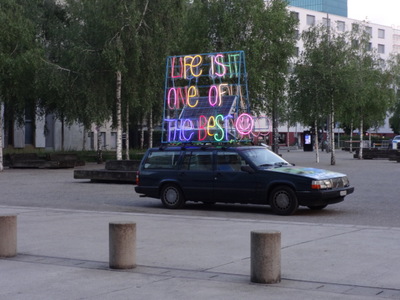 For dessert, I had thought of ordering the mysterious "sgroppino" I had seen on the menu the night before, but in the meantime I looked it up: it's lemon sorbet with proseco and vodka (sort of the Italian version of the French "coupe colonel"), not my kind of thing at all. So I once again ordered ice cream, hazelnut this time, garnished with fresh red currants.
For dessert, I had thought of ordering the mysterious "sgroppino" I had seen on the menu the night before, but in the meantime I looked it up: it's lemon sorbet with proseco and vodka (sort of the Italian version of the French "coupe colonel"), not my kind of thing at all. So I once again ordered ice cream, hazelnut this time, garnished with fresh red currants.
As we strolled home to the hotel, I got this shot of a car we'd seen in the square before the restaurant both coming and going on both nights, but this time it was lit up. The neon says "Life is one of the best," a fitting sentiment for the last night of this year's European adventure.
Previous entry
List of Entries
Next entry

 First order of business, though, was breakfast, which was complicated by the temporary closure of the hotel's restaurant for renovation. Regular restaurant operations, including breakfast, had been moved to the bar on the top floor, but he special Viking breakfast was served in a second-floor ballroom, just for us. It featured all the usual suspects, but a particularly nice set of pastries, different from the French and German ones, including this sugar-powdered, almond sprinkled bear-claw sort of thing, one end of which had been dipped in chocolate and which was presented in its own little orange paper bag. Delicious!
First order of business, though, was breakfast, which was complicated by the temporary closure of the hotel's restaurant for renovation. Regular restaurant operations, including breakfast, had been moved to the bar on the top floor, but he special Viking breakfast was served in a second-floor ballroom, just for us. It featured all the usual suspects, but a particularly nice set of pastries, different from the French and German ones, including this sugar-powdered, almond sprinkled bear-claw sort of thing, one end of which had been dipped in chocolate and which was presented in its own little orange paper bag. Delicious!
 The first landmark the bus took us by was the Swiss National Musuem, housed in a medieval-style building, of which this tower marks one corner.
The first landmark the bus took us by was the Swiss National Musuem, housed in a medieval-style building, of which this tower marks one corner.
 Our walking tour passed by the pleasure-boat basin on the Limmat, right downtown. Apparently, the best way to get a spot there for your boat is to inherit it. You have to pay a monthly fee just to stay on the waiting list for a slip!
Our walking tour passed by the pleasure-boat basin on the Limmat, right downtown. Apparently, the best way to get a spot there for your boat is to inherit it. You have to pay a monthly fee just to stay on the waiting list for a slip!
 As we approached the large square at the left, it abruptly cleared itself of the motley assortment of delivery vans and trucks that had cluttered it up. It's a pedestrian zone, but trucks are allowed access for deliveries until some particular hour of the morning, and our guide had timed our arrival well. At the far end, near the left-hand edge of the photo is a cluster of greenery, shown in closer view at the right. It's a collection of potted vegetation placed and maintained there in protest of climate change and deforestation. It includes everything from culinary herbs to marigolds, to strawberries, to sunflowers, tomatoes, and small trees.
As we approached the large square at the left, it abruptly cleared itself of the motley assortment of delivery vans and trucks that had cluttered it up. It's a pedestrian zone, but trucks are allowed access for deliveries until some particular hour of the morning, and our guide had timed our arrival well. At the far end, near the left-hand edge of the photo is a cluster of greenery, shown in closer view at the right. It's a collection of potted vegetation placed and maintained there in protest of climate change and deforestation. It includes everything from culinary herbs to marigolds, to strawberries, to sunflowers, tomatoes, and small trees.
 Here's a nearer view of the fountain. Like the ones in Basel, all the public fountains in Zurich (1,224 of them) pour cold potable water, and so far as I know, there's no exception like the Tinguely fountain. Because of the design of this one, though, you'd have to wade in knee deep to stick your bottle under the spout.
Here's a nearer view of the fountain. Like the ones in Basel, all the public fountains in Zurich (1,224 of them) pour cold potable water, and so far as I know, there's no exception like the Tinguely fountain. Because of the design of this one, though, you'd have to wade in knee deep to stick your bottle under the spout.
 On the way to the center of the old town, from the square with the potted plants, we passed under this grasshopper sign over a restaurant. It was a lovely light green, but the color doesn't show in this silhouette.
On the way to the center of the old town, from the square with the potted plants, we passed under this grasshopper sign over a restaurant. It was a lovely light green, but the color doesn't show in this silhouette.
 Here's the window of the Teuscher chocolate shop, which we passed on our walk. It took me four shots to show all of it! The assortment starts at the left with glacé orange slices dipped in white, light, and dark chocolate. Then a tray of glacé orange wedges dipped in dark and light chocolate. Then Florentine cookies studded with almond slices and bits of glacé fruit with light chocolate.
Here's the window of the Teuscher chocolate shop, which we passed on our walk. It took me four shots to show all of it! The assortment starts at the left with glacé orange slices dipped in white, light, and dark chocolate. Then a tray of glacé orange wedges dipped in dark and light chocolate. Then Florentine cookies studded with almond slices and bits of glacé fruit with light chocolate.
 Next came almond truffles, cocoa truffles, Bailey's truffles, orange truffles, jasmine truffles, and white, dark, and light truffles. The foil-wrapped ones at the far end of the line of Jasmine truffles were molded into the shape of Volkswagen beetles.
Next came almond truffles, cocoa truffles, Bailey's truffles, orange truffles, jasmine truffles, and white, dark, and light truffles. The foil-wrapped ones at the far end of the line of Jasmine truffles were molded into the shape of Volkswagen beetles.
 In a covered passage we traversed on our way was this archeological display. At the left is one of the bilingual information panels that lined the walls. (Interestingly, the panels were in German and English, but not in French or Italian.)
In a covered passage we traversed on our way was this archeological display. At the left is one of the bilingual information panels that lined the walls. (Interestingly, the panels were in German and English, but not in French or Italian.) 
 In the heart of the oldest section of town, we came to this coffee shop (selling beans and ground coffee, not the finished drink), the only coffee roaster in the old town. In the open window to the street, the proprietor was tending to the big coffee roaster. They only roast a couple of times a week, and Viking and our guide managed to get us there at the right time. The whole street smelled delicious! In the old town, some of the foundations go back to the 13th century, but the names of the houses date only from the 19th century.
In the heart of the oldest section of town, we came to this coffee shop (selling beans and ground coffee, not the finished drink), the only coffee roaster in the old town. In the open window to the street, the proprietor was tending to the big coffee roaster. They only roast a couple of times a week, and Viking and our guide managed to get us there at the right time. The whole street smelled delicious! In the old town, some of the foundations go back to the 13th century, but the names of the houses date only from the 19th century.
 Unfortunately, photography was forbidden inside the cathedral, but here, at the left, is a view of the outside of a particularly nice "stained glass" window, above the door we went in. Rather than glass, it's made of a mosaic of thin slices of agates, large and small. It's amazing enough from this side, but from indoors, with the sun behind it, it was gorgeous. If you want to climb the 287 steps, you can visit the cathedral tower. We didn't (and wouldn't have even if the tour allowed time).
Unfortunately, photography was forbidden inside the cathedral, but here, at the left, is a view of the outside of a particularly nice "stained glass" window, above the door we went in. Rather than glass, it's made of a mosaic of thin slices of agates, large and small. It's amazing enough from this side, but from indoors, with the sun behind it, it was gorgeous. If you want to climb the 287 steps, you can visit the cathedral tower. We didn't (and wouldn't have even if the tour allowed time).
 Across the river from the cathedral (and running along one side of the square with the swan-necked fountain) is the Fraumünster, the womens' church. The gold clock dates from 1732. The abbey was founded in 853, on the remains of a former abbey for aaristrocratic women, by Charlemagne's grandson Louis for his daughter Hildegard. Because it was under his direct authority, the Grossemünster had no authority over it, even though it was the senior institution, founded by Charlemagne himself. A later king granted the convent, which already owned a lot of land, the right to hold markets, collect tolls, and mint coins, so the abbesses were very powerful. The bishops in the Grossemünster weren't happy about it, but they couldn't do anything about it. The nunneries were closed after the reformation, and in the 1520's the church was handed over to the city. For 5 francs, you can go in with an audioguide to see the Chagall windows, but we didn't.
Across the river from the cathedral (and running along one side of the square with the swan-necked fountain) is the Fraumünster, the womens' church. The gold clock dates from 1732. The abbey was founded in 853, on the remains of a former abbey for aaristrocratic women, by Charlemagne's grandson Louis for his daughter Hildegard. Because it was under his direct authority, the Grossemünster had no authority over it, even though it was the senior institution, founded by Charlemagne himself. A later king granted the convent, which already owned a lot of land, the right to hold markets, collect tolls, and mint coins, so the abbesses were very powerful. The bishops in the Grossemünster weren't happy about it, but they couldn't do anything about it. The nunneries were closed after the reformation, and in the 1520's the church was handed over to the city. For 5 francs, you can go in with an audioguide to see the Chagall windows, but we didn't.
 Our walking tour ended at the waterfront. Zurich sits wrapped around the northern tip of the long, narrow Lake Zurich. For those who whose not to take the lake cruise, the guide pointed out the tram that would take them back to the hotel after they continued their stroll on land. The rest of us piled aboard a boat for the 1-hour counterclockwise circuit along one bank, across the lake, and back along the other bank. Around the boat slip, I saw swans, cormorants, and one moorhen (not to mention some folks on stand-up paddle boards). Our circuit was the shortest available—3-hour, half-day, and full day cruises were also offered. Our guide narrated for us in English over the PA system, but some locals were clearly aboard using the boat for transportation rather than tourism. Waiters circulated, taking drink orders, but we abstained.
Our walking tour ended at the waterfront. Zurich sits wrapped around the northern tip of the long, narrow Lake Zurich. For those who whose not to take the lake cruise, the guide pointed out the tram that would take them back to the hotel after they continued their stroll on land. The rest of us piled aboard a boat for the 1-hour counterclockwise circuit along one bank, across the lake, and back along the other bank. Around the boat slip, I saw swans, cormorants, and one moorhen (not to mention some folks on stand-up paddle boards). Our circuit was the shortest available—3-hour, half-day, and full day cruises were also offered. Our guide narrated for us in English over the PA system, but some locals were clearly aboard using the boat for transportation rather than tourism. Waiters circulated, taking drink orders, but we abstained.
 Coming back along the other bank, we passed this point, where Tina Turner lives. The guide said "where the three flags are by the little yellow house and the little wooden house." You can clearly see the little wooden house (not a dwelling, but someone's lakeside cabana), and the little yellow house may be the one at the left edge of the photo, but I never spotted any three flags.
Coming back along the other bank, we passed this point, where Tina Turner lives. The guide said "where the three flags are by the little yellow house and the little wooden house." You can clearly see the little wooden house (not a dwelling, but someone's lakeside cabana), and the little yellow house may be the one at the left edge of the photo, but I never spotted any three flags. 
 When our tour ended, buses picked us up for the ride back to the hotel. We were leaving again in short order for our afternoon visit to the chocolate factory, so we just went to the hotel's makeshift restaurant and ordered the daily special. It started with the salad at the left, which included big chunks feta cheese.
When our tour ended, buses picked us up for the ride back to the hotel. We were leaving again in short order for our afternoon visit to the chocolate factory, so we just went to the hotel's makeshift restaurant and ordered the daily special. It started with the salad at the left, which included big chunks feta cheese.
 Surprisingly, only 10 people signed up for the chocolate visit, so they took us around the lake to the factory in a special smaller bus. At the left here is the beautiful lobby we were ushered into. In the glass cases were giant versions of the opulent ads the company runs in magazines like Saveur and Bon Appetit.
Surprisingly, only 10 people signed up for the chocolate visit, so they took us around the lake to the factory in a special smaller bus. At the left here is the beautiful lobby we were ushered into. In the glass cases were giant versions of the opulent ads the company runs in magazines like Saveur and Bon Appetit.
 Then, upstairs, under the watchful eyes of these portraits of Mr. Lindt (left) and Mr. Sprungli (right) we were given a little history.
Then, upstairs, under the watchful eyes of these portraits of Mr. Lindt (left) and Mr. Sprungli (right) we were given a little history.
 In a special spacious dressing room, lined with hand-washing sinks, we were presented with our official chocolate-making attire and suited up. In the left-hand photo, you can see me in the mirror, camera in front of my eyes. As you can see, my apron is hanging crooked.
In a special spacious dressing room, lined with hand-washing sinks, we were presented with our official chocolate-making attire and suited up. In the left-hand photo, you can see me in the mirror, camera in front of my eyes. As you can see, my apron is hanging crooked.
 Next, we passed through swinging doors into the "Chocolateria," a sort of kitchen/lab with gleaming marble benchtops and water-jacketed copper warming vats full of milk and dark chocolate. You can only see about a quarter of it here. Mostly out of the shot to the right is the table, centered at the front of the room, with plastic display models of cocoa pods, seeds, and nibs.
Next, we passed through swinging doors into the "Chocolateria," a sort of kitchen/lab with gleaming marble benchtops and water-jacketed copper warming vats full of milk and dark chocolate. You can only see about a quarter of it here. Mostly out of the shot to the right is the table, centered at the front of the room, with plastic display models of cocoa pods, seeds, and nibs.
 When we had all successfully filled our truffles (and spilled only a few splodges of liquid chocolate onto the trays and benches) the assistant took them to a nearby fridge to be gently cooled and solidified.
When we had all successfully filled our truffles (and spilled only a few splodges of liquid chocolate onto the trays and benches) the assistant took them to a nearby fridge to be gently cooled and solidified.


 At the left here, he's preparing to make even tinier dark chocolate dots to serve as pupils in the little mouse's eyes.
At the left here, he's preparing to make even tinier dark chocolate dots to serve as pupils in the little mouse's eyes.
 Then it was our turn. By this time, the assistant had filled enough tiny pastry bags for everyone, and they were waiting for us on the edges of our kettles. Everybody got a dipping fork. I choose to dip all of my centers entirely into the milk chocolate in the nearest kettle, then to apply some of every kind of decoration and to pipe on detail. Mine aren't as neat as the chef's, but I thought they came out very well. I chose not to make a mouse, because I knew we were going to have to try to get these home on the plane, and the standing-up ears seemed awfully fragile. David's also came out great.
Then it was our turn. By this time, the assistant had filled enough tiny pastry bags for everyone, and they were waiting for us on the edges of our kettles. Everybody got a dipping fork. I choose to dip all of my centers entirely into the milk chocolate in the nearest kettle, then to apply some of every kind of decoration and to pipe on detail. Mine aren't as neat as the chef's, but I thought they came out very well. I chose not to make a mouse, because I knew we were going to have to try to get these home on the plane, and the standing-up ears seemed awfully fragile. David's also came out great.

 David meanwhile tossed them in the sugar to make sure they were entirely coated, then transferred them to a drum sieve (left; just like the ones he used to use in the lab!), rolled them around gently to remove excess sugar, and transferred them back to their trays to harden and dry. which only took a few moments.
David meanwhile tossed them in the sugar to make sure they were entirely coated, then transferred them to a drum sieve (left; just like the ones he used to use in the lab!), rolled them around gently to remove excess sugar, and transferred them back to their trays to harden and dry. which only took a few moments.
 Carrying our boxes in the little designer Lindt shopping bags we were given for the purpose, we piled back into our bus for the trip around the block to the flagship Lindt chocolate shop. At the door, we were greeted by a hostess pressing upon us samples of the latest Lindor truffle flavor—pistachio. At the left is part of the section of the store devoted to filling your shopping bag with your own selection of Lindor truffles. And it is worth noting there that this was photo #9999 on my camera, which, with the next shot, rolled over and started again at #1.
Carrying our boxes in the little designer Lindt shopping bags we were given for the purpose, we piled back into our bus for the trip around the block to the flagship Lindt chocolate shop. At the door, we were greeted by a hostess pressing upon us samples of the latest Lindor truffle flavor—pistachio. At the left is part of the section of the store devoted to filling your shopping bag with your own selection of Lindor truffles. And it is worth noting there that this was photo #9999 on my camera, which, with the next shot, rolled over and started again at #1.
 Back at the hotel, we decided to stick with a winner and just strolled back over to Toscano for dinner. The lady at the table beside us the evening before had raved about her tagliolini with black truffles, so I ordered that and the octopus-and-potato starter, to be served together, since David was ordering only a single course.
Back at the hotel, we decided to stick with a winner and just strolled back over to Toscano for dinner. The lady at the table beside us the evening before had raved about her tagliolini with black truffles, so I ordered that and the octopus-and-potato starter, to be served together, since David was ordering only a single course.
 David chose the ribeye steak, which was grilled, then sliced thickly and stacked atop a pile of arugula and tomatoes and topped with a sauce of porcini mushrooms.
David chose the ribeye steak, which was grilled, then sliced thickly and stacked atop a pile of arugula and tomatoes and topped with a sauce of porcini mushrooms.
 For dessert, I had thought of ordering the mysterious "sgroppino" I had seen on the menu the night before, but in the meantime I looked it up: it's lemon sorbet with proseco and vodka (sort of the Italian version of the French "coupe colonel"), not my kind of thing at all. So I once again ordered ice cream, hazelnut this time, garnished with fresh red currants.
For dessert, I had thought of ordering the mysterious "sgroppino" I had seen on the menu the night before, but in the meantime I looked it up: it's lemon sorbet with proseco and vodka (sort of the Italian version of the French "coupe colonel"), not my kind of thing at all. So I once again ordered ice cream, hazelnut this time, garnished with fresh red currants.